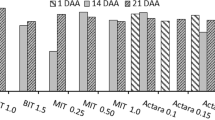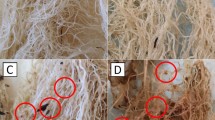Abstract
IT has previously been reported that dimefox (bis-dimethylamino fluorophosphine oxide) when applied to the root system of cacao trees can control Pseudococcus njalensis Laing, the common mealybug vector of the swollen shoot virus in the Gold Coast1,2. The toxic action of the chemical persists within the tree for about eight weeks.
This is a preview of subscription content, access via your institution
Access options
Subscribe to this journal
Receive 51 print issues and online access
$199.00 per year
only $3.90 per issue
Buy this article
- Purchase on Springer Link
- Instant access to full article PDF
Prices may be subject to local taxes which are calculated during checkout
Similar content being viewed by others
References
West, J., Cacao Conference Report 1951, 86. Nicol, J., Nature, 169, 129 (1952).
Hanna, A. D., Heatherington, W., and Judenko, E., Nature, 169, 334 (1952).
Author information
Authors and Affiliations
Rights and permissions
About this article
Cite this article
HANNA, A., NICOL, J. Application of a Systemic Insecticide by Trunk Implantation to control a Mealybug Vector of the Cacao Swollen Shoot Virus. Nature 173, 730–731 (1954). https://doi.org/10.1038/173730b0
Issue Date:
DOI: https://doi.org/10.1038/173730b0
This article is cited by
-
The effects of mild cacao swollen shoot virus strains N1 and SS365B on growth and yield of cacao
Journal of General Plant Pathology (2018)
-
Techniques for labelling Trees with Radioactive Phosphorus
Nature (1955)
Comments
By submitting a comment you agree to abide by our Terms and Community Guidelines. If you find something abusive or that does not comply with our terms or guidelines please flag it as inappropriate.



